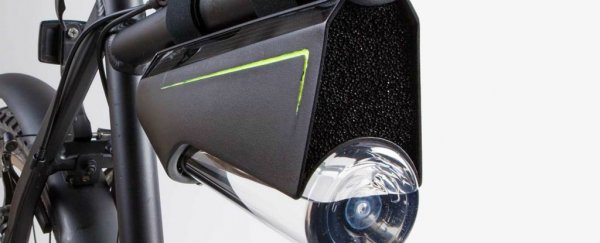An Austrian start-up has revealed plans to start selling a self-filling water bottle that extracts humidity from the air and condenses it into drinkable water at a rate of up to 0.5 litres per hour - provided it's a really humid day.
Developed by the team at Fontus, the solar-powered device uses hydrophobic surfaces to repel and funnel the drops of condensation in the bottle, which means so as long as the air around you isn't too polluted, you'll have access have a constant supply of clean drinking water.
"This is simply condensation of the humidity that is contained in the air," Fontus founder Retezár Kristof told Denise Chow at Live Science. "You always have a certain percentage of humidity in the air, it doesn't matter where you are - even in the desert. That means you would always potentially be able to extract that humidity from the air."
The water bottle - which is currently getting the crowdfunding treatment to facilitate mass-production - is being marketed as an aid for long-distance cyclists who don't have time to stop off and top-up. When it goes on sale, it'll come with a bike-attachment, as seen in the video below.
That's the first-world application of the technology, but the benefits are obvious for the 1.2 billion people in the world who are living in areas where clean water is scarce.
"The idea was to solve a global problem: water issues in areas of the world where there is very little groundwater but very high humidity," Retezár said. "My intent was to invent a machine or device that would be able to filter the humidity in the air and turn it into drinkable water."
The device is made up of a solar panel, a condensing chamber lined with hydrophobic surfaces, and a very basic filter to keep dust, dirt, and bugs out of the mix. It works by taking in warm, humid air, which is condensed down into water droplets that are funnelled into the water bottle below because the hydrophobic surfaces prevent them from sticking.
"Because they're hydrophobic, they immediately repel the condensed water that they created, so you get a drop flow [into the bottle]," Retezár told Live Science. "Basically, you're taking air in a vapour state and converting it into a liquid state."
When it hits the market, the bottle will come in two models - the 'Airo', and the 'Ryde', which is being made specifically for cyclists. Retezár and his team say if you've got with temperatures 30 to 40 degrees Celsius (86 degrees to 104 degrees Fahrenheit) and 80 to 90 percent humidity, you can hit that impressive 0.5 litres per hour fill-rate.
The developers have also mentioned the possibility of adding a carbon filter to the mix, which could be used to filter out clean water from more polluted areas.
Now, all of this does sound pretty awesome, but of course it does - Fontus wants to sell a lot of these things. While the principle of the thing sounds like it would work as advertised, until we see tests from independent parties, we have to remain skeptical.
According to Eric Mack at Gizmag, the company says it plans to release third-party white paper data at some point, which will include "reference temperature, humidity settings, duration, and resultant volume of water created", and separate 'validation tests' are going to be funded by some of those crowdfunding dollars.
Watch this space.
